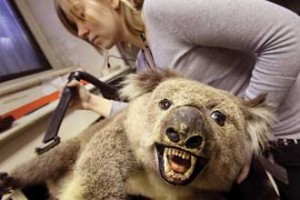
Redpath’s unseen collection a treasure-trove of the weird and wonderful
By Neale McDevitt
As you enter the basement, a crocodile bares its fangs menacingly from atop a locker. On either side of him, a row of black-eyed creatures, from badgers to razor-toothed fish, grimace and scowl. Nearby, a python squeezes the life out of a hapless muskrat. Retreating into a room, you stumble upon a veritable bone yard, with shelf after shelf stacked high with all manner of skeletal legs, skulls and ribs. Passing through an adjoining door, you find yourself surrounded by thousands of jars containing slippery, multi-legged creatures and tentacled monsters pulled from the depths of your worst nightmare.
But this is no bad dream, it’s just the basement of the Redpath Museum, the labyrinthine repository for hundreds of thousands of specimens and artifacts not quite ready for the prime time of the display galleries upstairs.
“A lot of the materials we have are teaching materials and much of it is not display quality,” said the museum’s Director, David Green, who estimates that a mere one per cent of the Redpath’s 400,000 or so specimens are actually seen by the public. “Putting a pickled fish in a jar on display just isn’t that aesthetically appealing. But it may be very valuable for research teaching.”
With the extra world cultures artifacts squirreled away in a storage area upstairs, the basement is home to all of the Redpath’s surplus paleontology, mineralogy and geology, and vertebrate and invertebrate zoology specimens. The dry collection includes everything from animal skins and rocks and minerals to antique mounted animals and a complete gorilla skeleton, while the wet collection is stored in a room crammed with jars containing all manner of fish, reptiles and amphibians floating in ethanol.
The problem is the collection keeps growing, “It’s the kind of problem that a good research museum wants to have. We have lots of people doing lots of work and being very productive,” said Green “Hans Larsson, is a paleontologist, so he brings back fossils – sometimes very big fossils. I work in amphibians, so I bring back frogs and the like. Virginie Millien brings back small mammals. Andrew Hendry brings back fish and birds… and so on.
“We’re getting very good at packing more stuff into less and less space.”
